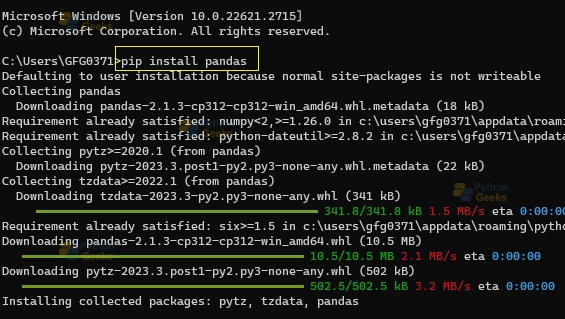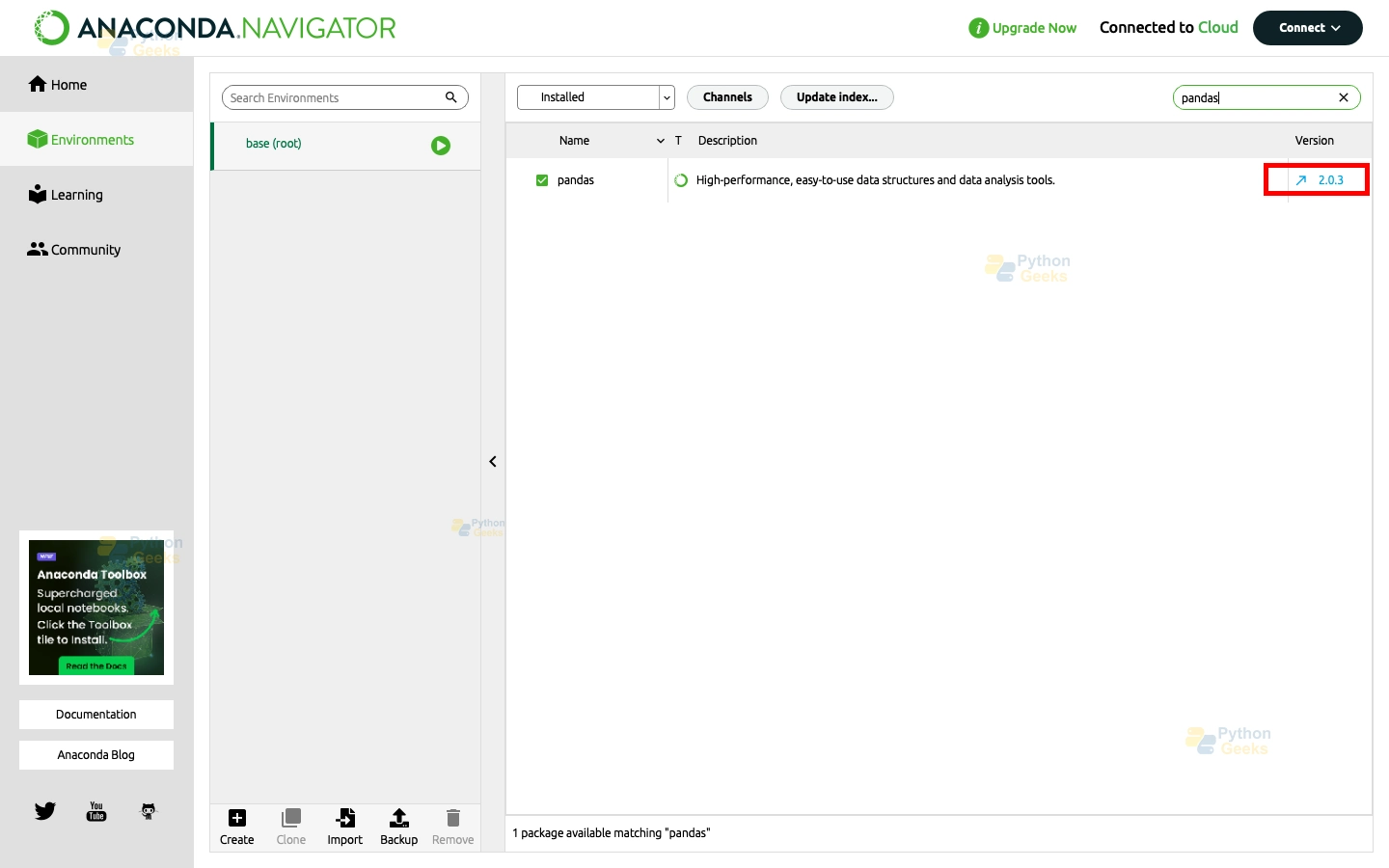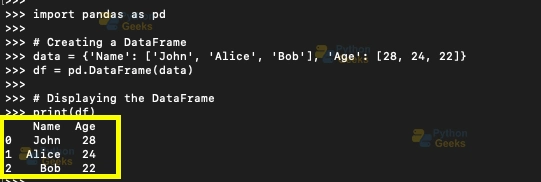How to Install Pandas in Python?
We offer you a brighter future with FREE online courses - Start Now!!
Pandas is a flexible and user-pleasant Python library that is at the top of making the regularly complex subject of facts evaluation less difficult to apprehend. In the world of Python computing, it’s very critical because it presents an easy-to-use and powerful way to work with, look at, and show records. Because of its particular structure and simplicity of use, it’s a valuable device for new and skilled statisticians.
Unleashing the Power of Data Handling:
Pandas is fantastic at making managing records less complicated via providing you with simple information structures like DataFrames that make it less complicated to alternate tables and time series statistics. Making information operations honest is on the coronary heart of the library’s design principle. This lets customers do complicated obligations with little to no code.
Your Key to Data Operations That Are Easy for Users:
Pandas does not have the steep knowledge of curves that is often related to evaluating statistics because its grammar is clean and expressive. No matter how much programming, Pandas lets you do complex duties with only a few strains of code. This person-pleasant approach makes the sphere of statistics evaluation an extra welcoming vicinity for folks who are just starting out.
A Key Part of Python Data Science:
It’s now not only a device; Pandas is an important part of the Python statistics era stack. It is used in many fields, along with finance, healthcare, and education, and its adaptability and value make it an essential device for both information specialists and fans. After reading the next guide, we’re going to begin the process of installing Pandas with the purpose of opening the door to a world of smooth and useful Python records analysis skills.
Let’s know about all the required prerequisites:
Before the positive view of the Pandas world, please be sure that you’ve got the suitable tools. Here are the basic requirements for getting started: Here are the basic requirements for getting started:
1. Python Installation:
Install Python programs on your OS. On the off case that you don’t have python installed, you can get the newest version from the official python website.
Following the download, continue by installing the software as per the instruction for your operating system. When installing, tick the box showing ‘Add Python to PATH’ to save applying the path to Python manually.
To confirm that Python is installed, open a terminal (or command prompt) and type the following command: To confirm that Python is installed, open a terminal (or command prompt) and type the following command:
You can now see the Installed Python Version on your computer
2. Terminal or Command Prompt:
From this on, we will be using a terminal, for instance, a terminal of Linux or MacOS or a command prompt (Windows) to execute commands. Make yourself familiar with and be able to navigate and run commands comfortably in your preferred provisioned command environment.
On Windows, you can depend on Command Prompt and PowerShell. On Linux and MacOS Open up terminal.
To test your command-line environment, open the terminal or command prompt and type: To test your command-line environment, open the terminal or command prompt and type:
echo "Hello, Pandas!"
If the result is correct, “Hello, Pandas!” should be in the output.
When Python is in place and your command-line environment is configured, then, you’re ready to start the Pandas installation process, do it, and discover the power of data analysis capabilities it has. What we need to do now is progress to the subsequent phase.
Modes of Installation
Next, we’ll get the Python base set and the command line interface; from this point, let’s see the different options for the installation of Pandas. Firstly is how you Pandas the pandas. We look into all the Pictures first to understand the relationship they share with each other. We will speak about them: a possible trajectory includes the use of “pip” for package management in Python and “conda” — a reported package management tool that is often linked with Anaconda distribution. These are the steps I preach to make your download clean whether you use Windows, Linux, or MacOS. OK, let’s roll up our sleeves and see how smart Pandas can be for our system’s operations.
Installing Pandas on Windows using pip:
If you are a Windows user, on the contrary, pandas installation with pip becomes as simple as this. Here’s a step-by-step guide:
1. Open the Command Prompt or PowerShell:
Run Command Prompt by pressing “Win + R” and typing “cmd”< then Enter>.
When it comes to PowerShell, you should press “Win + X” and pick “Windows PowerShell.”
2. Update pip (optional but recommended):
Regularly check pipe’s update. Run the following command:
python -m pip install –upgrade pip (kernels) FINISH THE INPUT: By prioritizing clean energy sources, electric vehicles minimize environmental pollution and contribute to reducing air pollution and global warming.
3. Install Pandas:
Use the following command to install Pandas using pip: Use the following command to install Pandas using pip:
pip install pandas
4. Verify Installation:
After the set up is entire, you can verify it with the aid of checking the Pandas model:
python -c "import pandas as pd; print(pd.__version__)"
If the whole thing is set up efficiently, you need to see the installed Pandas version. Now you’ve got Pandas hooked up on your Windows machine, and you are equipped to leverage its data analysis abilities.
Installing Pandas on MacOS/Linux using pip:
For MacOS and Linux users, putting in Pandas using pip is a truthful process. Follow the steps:
1. Open the Terminal:
Under MacOS, you can either open up Applications or go with the shortcuts `Cmd Space` then `Terminal` in Spotlight followed by pressing `Enter`.
One the way “Linux” is employed it is possible to utilize key combination `Ctrl Alt T` to open the Terminal.
2. Update pip (elective however recommended):
Try to install the newest version of pip before installing Pandas; This way you will eliminate unnecessary problems. Run the subsequent command:
python -m pip install --upgrade pip
3. Installing Pandas:
Now Use the following command to install Pandas using pip: Use the following command to install Pandas using pip:
pip install pandas
4. Verify Installation:
After the installation is entire, you can confirm it through checking the Pandas version: After the installation is entire, you can confirm it through checking the Pandas version:
python -c "import pandas as pd; print(pd.__version__) "
What you need to remember during the entire installation process is to look for the given `Pandas version` instructions. Now you are ready to grow as your Pandas environment is also set up for a macOS or a Linux machine; so, you are ready to explore its abilities for analysis for facts.
Installing Pandas using Anaconda:
For customers with Anaconda, putting in Pandas is a breeze. Anaconda is a distribution that comes with many pre-set up records technological know-how programs, along with Pandas. Follow these steps for Windows, MacOS, and Linux:
1. Open the Anaconda Prompt:
- On Windows, you may open the Anaconda Prompt from the Start menu.
- On MacOS and Linux, open the Terminal.
2. Update Conda (non-obligatory however endorsed):
- It’s an awesome exercise to ensure you have got the modern day model of conda. Run the subsequent command:
conda update -n base -c defaults conda
3. Install Pandas:
- Use the following command to install Pandas the use of anaconda:
conda deploy pandas
4. Verify Installation:
- After the set up is whole, you may verify it by means of checking the Pandas version:
python -c "import pandas as pd; print(pd.__version__)"
- If the whole thing is installed efficiently, you should see the established Pandas version.
- You can also verify the set-up within the anaconda navigator by searching “pandas” manually.
Now you have got Pandas installed via Anaconda, ensuring a smooth integration with other records technological know-how gear. Whether you are on Windows, MacOS, or Linux, Anaconda provides a steady surroundings on your statistics evaluation desires.
Verifying Pandas Installation:
After the installation of Pandas, it is important to confirm that the installation has become a success. Here are clean steps to verify that Pandas is prepared to use:
1. Open the Command Prompt, PowerShell, or Terminal:
- Depending on your running gadget (Windows, MacOS, or Linux), open the right command-line interface.
2. Launch Python:
- Type the subsequent command and press Enter to release the Python interpreter:
python
This ought to open the Python interactive shell.
3. Import Pandas:
Once within the Python shell, import Pandas with the aid of typing: Once within the Python shell, import Pandas with the aid of typing:
import pandas as pd
4. Check Pandas Version:
- Verify the installed Pandas version with the aid of typing: Verify the installed Pandas version with the aid of typing:
print(pd.__version__)
- So, if Pandas was designed in a way that works perfectly, the model number should feature zero errors, for sure.
5. Run a Quick Test:5. Run a Quick Test:
Indeed, the best way to start is to perform a small test, thus creating a simple DataFrame and looking through its table. Type the subsequent instructions:
import pandas as pd
# Creating a DataFrame
data = {'Name': ['John', 'Alice', 'Bob'], 'Age': [28, 24, 22]}
df = pd.DataFrame(data)
# Displaying the DataFrame
print(df)
Output :
This ought to create a DataFrame and show its contents, confirming that Pandas is functioning as predicted. By following those steps, you may make sure that Pandas is established and operational in your machine.
Common Issues and Troubleshooting:
Among these troubles awaits the customers coming next after Pandas. Here are a few troubleshooting hints and answers to address functionality troubles: Here are a few troubleshooting hints and answers to address functionality troubles:
1. Outdated Pip or Conda:1. Outdated Pip or Conda:
Issue: The antiquated build managers’ pip or conda package might additionally corrupt compatibility.
Solution:
- For pip, replace it by using walking: “python -m pip set up –upgrade pip”, where the pip command is running in the pip module.
- For conda, update it with: “conda update -n base -c conda”.
2. Permission Errors:
Issue: In the mentioned case, the protection mode may save you the imperative.
Solution:
- On Unix-based totally totally structures, use “sudo” earlier than the set up command: To install pandas, simply type the following command: “sudo pip install pandas”.
- On the windows, invoke both the command prompt and PowerShell as an administrator.
3. Network Issues:
Issue: During the installation process, my internet either slows considerably or, at times, it becomes unstable.
Solution:
- I might try it again when I see that the internet connection is up and all.
- Provide your client with tips for alternative measures such as using replicas or proxies if the connection issues don’t settle down.
4. Dependencies Conflict:
Issue: It is a pain as there are many other applications or brush with Pandas.
Solution: The single item is responsible for producing all required parts and they are all integrated into the digitally isolated environment.
python -m venv myenv
deliver myenv/bin/set off # On Unix-primarily based totally structures
pip installation pandas
Alternatively, use conda to create an environment: “conda create –name myenv pandas”.
5. Unsupported Python Version:
Issue: Using an unsupported Python version.
Solution: Ensure you are using a model of Python supported with the aid of the manner of the hooked up Pandas version. Check the Pandas documentation for compatibility.
6. Anaconda Installation Issues:
Issue: Problems putting in Pandas using conda within Anaconda.
Solution:
- Update Anaconda with: conda replace anaconda
- If troubles persist, test the Anaconda documentation or network boards for assistance.
7. Firewall/Antivirus Blocking:
Issue: Firewall or antivirus software software may block the installation.
Solution: Temporarily disable the firewall or antivirus and try the installation again.
8. Check System Requirements:
Issue: Pandas may additionally have specific tool necessities.
Solution: Verify that your device meets the requirements referred to inside the Pandas documentation.
If customers stumble upon troubles which cause chaos, it inspires them to search for advice from the professional Pandas documentation, community forums, or applicable Python boards for additional help. Additionally, searching for the unique error message can often motivate beneficial answers from the wider programming community.
Required Dependencies:
1. NumPy (Minimum supported version: 1.22.4):
As the cornerstone of numerical computing in Python, NumPy affords the fundamental constructing blocks for pandas’ array-based total information systems and operations.
2. Python-dateutil (Minimum supported version: 2.8.2):
Python-dateutil enriches pandas with effective date and time parsing capabilities, facilitating seamless handling of temporal statistics.
3. Pytz (Minimum supported model: 2020.1):
Pytz complements pandas’ time region functionality, allowing users to work effortlessly with datetime gadgets throughout exclusive time zones.
4. Tzdata (Minimum supported version: 2022.7):
Tzdata ensures pandas stays updated with the modern day time area records, ensuring correct time region conversions and daylight hours saving modifications.
Optional Dependencies:
Performance Dependencies (Recommended):
numexpr (Minimum Version: 2.8.4): Accelerates numerical operations by leveraging more than one cores and efficient chunking techniques, unlocking giant velocity improvements.
Bottleneck (Minimum Version: 1.3.6): Specialized cython exercises in Bottleneck expedite positive sorts of operations related to NaN values, leading to huge performance profits.
Numba (Minimum Version: 0.56.4): Leveraging simply-in-time (JIT) compilation, Numba interprets Python capabilities into optimized device code, offering an opportunity execution engine for pick out pandas operations.
Visualization:
matplotlib (Minimum Version: 3.6.3): The cornerstone of information visualization in Python, Matplotlib empowers pandas with strong plotting abilities, enabling users to create insightful visualizations with ease.
Jinja2 (Minimum Version: 3.1.2): Jinja2 helps with conditional formatting with DataFrame.Style, allowing customers to personalize the arrival of their records representations.
Computation:
SciPy (Minimum Version: 1.10.0): A crucial library for medical computing, SciPy provides a plethora of miscellaneous statistical functions that supplement pandas’ analytical toolkit.
Xarray (Minimum Version: 2022.12.0): Offering a pandas-like API for N-dimensional data, x-array extends pandas’ competencies to deal with complicated multi-dimensional datasets seamlessly.
Excel Files:
xlrd (Minimum Version: 2.0.1): Facilitating reading operations for Excel documents, xlrd ensures pandas can ingest facts from Excel spreadsheet effects.
Xlsxwriter (Minimum Version: 3.0.5): Empowering pandas with the potential to write down statistics to Excel documents, xlsxwriter enables users to export their DataFrame contents to Excel without problems.
Openpyxl (Minimum Version: three.1.0): Offering complete analyzing and writing guide for xlsx documents, openpyxl enhances pandas’ interoperability with Excel codecs.
HTML:
BeautifulSoup4 (Minimum Version: 4.11.2): An HTML parser essential for reading HTML content material, BeautifulSoup4 enables pandas to extract records from HTML resources efficiently.
Html5lib (Minimum Version: 1.1): Complementing BeautifulSoup4, html5lib serves as an alternative HTML parser, ensuring sturdy HTML parsing competencies for pandas.
Lxml (Minimum Version: 4.9.2): Renowned for its speed and reliability, lxml enhances pandas’ HTML parsing abilities, ensuring efficient extraction of information from HTML assets.
Summary
This guide has shown you the way to successfully install Pandas, a bendy Python device that is important for brief data analysis. Pandas makes operating with statistics simpler via giving features that are clean for each new and skilled information scientists to use.
At a few factors, we delivered download methods for distinct Operating systems to ensure that Windows, MacOS, and Linux Users could use them. The verification steps helped us make certain that the setup worked, and the debugging pointers took care of commonplace troubles that could come up during the method.
At this point, Pandas is completely included in your Python environment, and you are geared up to start studying numbers. Check out what it is able to do, from efficiently preserving datasets to getting elaborate manipulation consequences. You can analyze Pandas and get around any annoying troubles by using the community and the huge assets. If you are interested in statistics-driven insights and findings, you can also work with Pandas as both academic and passion interests. Have fun coding!



